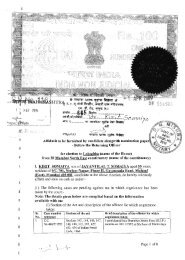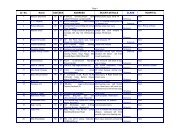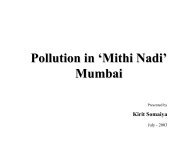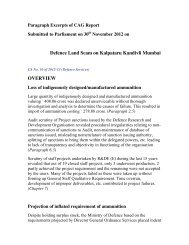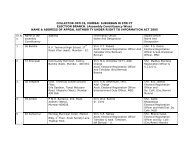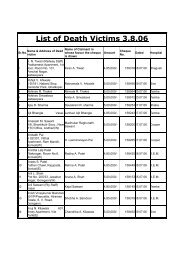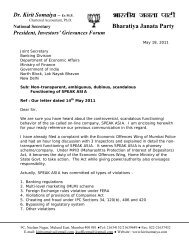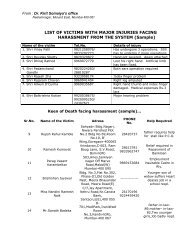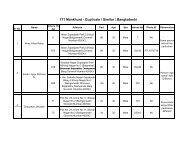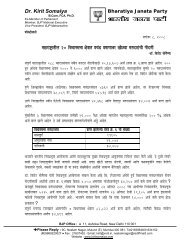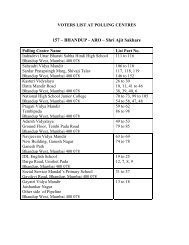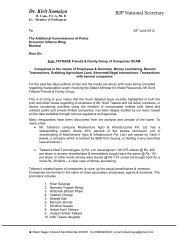Urban Developmet - KiritSomaiya.com
Urban Developmet - KiritSomaiya.com
Urban Developmet - KiritSomaiya.com
You also want an ePaper? Increase the reach of your titles
YUMPU automatically turns print PDFs into web optimized ePapers that Google loves.
..... Mumbai In Loksabha .....<br />
ANNEXURE<br />
ANNEXURE REFERRED TO IN REPLY TO PARTS (a) TO (d) OF LOK SABHA UNSTARRED<br />
QUESTION NO.148 FOR 26.2.2002.<br />
VALMIKI AMBEDKAR AWAS YOJANA (VAMBAY)<br />
Shelter is a basic human requirement. For a shelterless person, getting a house brings about a profound<br />
social change in status and welfare, endowing him with an identity and integrating him with his social<br />
milieu. The provisional estimates made from 2001 Census indicate that while India is urbanising<br />
markedly, slums in urban India are increasing alarmingly. The slum population in urban India is estimated<br />
to be about 62 million.<br />
There is at present no housing scheme in the Central Sector for the urban poor. There are two Central<br />
Sector programmes targeted towards the urban poor, namely the SJSRY and NSDP. The SJSRY attempts<br />
to provide employment in order to bring the urban poor above the poverty line while NSDP is basically<br />
a programme for the environmental improvement of urban slums. The urban poverty alleviation strategy<br />
is in<strong>com</strong>plete without a significant <strong>com</strong>ponent pertaiining to housing delivery for the slum dwellers.<br />
In order to fill this gap in a major policy initiative, the Prime Minister of India announced a new<br />
Centrally Sponsored Scheme called the Valmiki Ambedkar Awas Yojana (VAMBAY) on the 15th<br />
August, 2001 to ameliorate the conditions of the urban slum dwellers living below poverty line.<br />
The objective of VAMBAY is primarily to provide shelter or upgrade the existing shelter for people<br />
living below the poverty line in urban slums in a march towards the goal of slumless cities with a<br />
healthy and enabling urban environment. The target group under the VAMBAY will be all slum dwellers<br />
in urban areas who are below the poverty line including members of EWS who do not possess adequate<br />
shelter.<br />
Another very important basic amenity for slum dwellers especially in congested metropolitan cities is<br />
the lack of rudimentary toilet facilities. A new National City Sanitation Project under the title of<br />
‘Nirmal Bharat Abhiyan‘ is an integral sub <strong>com</strong>ponent of VAMBAY. 20% of the total allocation under<br />
VAMBAY will be used for the same at the rate of Rs.200 crores as loan from HUDCO and Rs.200<br />
crore as subsidy. The State Governments/Local Bodies of course will be free to supplement this amount<br />
with their own grant or subsidy as the case may be. The average cost for a <strong>com</strong>munity toilet seat has<br />
been estimated to be Rs.40,000/- per seat. Therefore, a 10-seat or a 20-seat toilet block meant for men,<br />
women and children with separate <strong>com</strong>partments for each group and special design features will cost<br />
around Rs.4 lakhs or Rs.8 lakhs respectively. Each toilet block will be maintained by a group from<br />
among the slum dwellers who will make a monthly contribution of about Rs.20 or so per family and<br />
obtain a monthly pass or family card.<br />
During the current financial year, 2001-02, a modest beginning may be made with a limited sum of<br />
Rs.100 crore made available out of the savings of the Ministry of <strong>Urban</strong> Development. However,<br />
during the 10th Plan period when VAMBAY will be launched in full swing, the annual allocation will<br />
be Rs.1000 crores which will be matched with a long-term loan by HUDCO of Rs.1000 crore on a 1:1<br />
basis. The rate of interest of this loan will be the same as the rate of interest charged by HUDCO for<br />
EWS housing. State Government has the option to mobilize its matching portion of 50% from other<br />
sources, such as their own budget provision, resources of local bodies, loans from other agencies,<br />
contributions from beneficiaries or NGOs etc. In all cases, however, the Government of India subsidy<br />
will only be released after the States matching share of 50% has been released. Both the subsidy and<br />
the loan (when it is required) will be released by HUDCO. The funds will be released by HUDCO<br />
either to the State <strong>Urban</strong> Development Agency (SUDA), District <strong>Urban</strong> Development Agency (DUDA)<br />
or any other agency designated by the State Government.<br />
78





